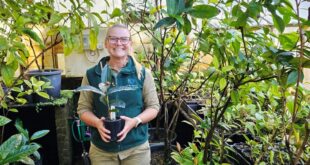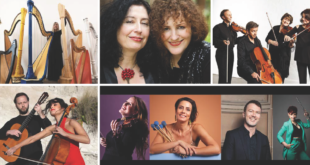
Lester Ives looks every part the bushman. He is gentle and softly spoken, yet something in his tall, lean frame reminds me of the eucalyptus trees he climbs for a living, in his work as an arborist. Maybe it’s the way he moves, each shift of his body the continuation of an earlier gesture, like a tree in wind.
Behind the wild beard, his bright, winsome eyes seem always to be smiling.
After entering the world at Katoomba Hospital, Lester grew up in the Blackheath home his grandfather built, his grandparents having settled in the area in the late 1800s. A love of nature, and the importance of growing things, was instilled in him at an early age. His folks had a market garden orchard, and his mother would sell vegies from the back door of their house.
“My father was born in that house and lived there on the property all his life. He passed away when I was 14. I continued growing vegies, cutting firewood, and operating farm machinery, whilst going to school.”
Lester did an electrical apprenticeship when he left school, working as a ‘sparky’ for the council, and he has worked as a welder and a carpenter. Even now he loves making bush furniture – after removing a tree that was dangerously overhanging my own house a few years ago, he used his chainsaw to carve a throne for my daughter from the stump. And then there is his wild side: he loves motor bikes. If you watch the documentary Stone Forever, you can see him on his 900cc Z1, doing a burnout through the middle of a pub.
Lester is also a member of the Remote Area Firefighting Team of the National Parks and Wildlife Services (NPWS), for whom he works casually as a Discovery Ranger, a role which suits him well. “ The environment is the classroom,” he says. “ The idea there is to conserve our natural and cultural heritage.” He speaks about the importance of communal connection to country, that it is there for everyone not only to enjoy and protect, but also to learn from. “It’s good to get all your senses working in the bush,” he says. “Smell, touch, feel, listen, the bush has a way of talking to you.”
“When you get out there and experience the bushland, you can learn from it. Just looking out there now, I can see all this bush tucker: there’s broad-leaved geebung, it’s got edible berries, bracken fern over there,” he points, “the young fronds you can mash into a paste. If you’re bitten by a bull ant, you can apply that and it eases the pain. If you can’t find that, you mash the roots and get the sap out of it. There are native currants. There’s the banksias there, you can run water through them and make a cordial out of it.” The bush, that spectacular, magical bush, which we are so fortunate to have surrounding us in the Blue Mountains, overflows with such lessons, if only we are open to them, if only we learn how to look. So too is Lester, who seems to possess an encyclopaedia of such knowledge.
Lester talks at length about biodiversity, about the many varieties of eucalyptus species in the National Park, about the varying layers of rock in the escarpment, and about the microclimates they can produce as they emerge and are eroded. He holds out a piece of chert stone and talks about its sedimentary formation, its high silica content. Lester completed an Advanced Certicate in Outdoor Guiding almost thirty years ago, where he learned about subjects ranging from geology and ecology to abseiling and photography. The group he was studying with did bushwalks every weekend, learning from each other, as well as the instructors and the bush. For Lester, this element of the course has echoes of Aboriginal practices: “Imagine all those thousands of years being in the bush, what you’d learn from the bush, walking country.” When the course was over, he and his colleagues did not want it to end, and, walking the Six Foot Track together on the way back from Jenolan Caves, they decided to form a bushwalking club, which they called “ The Gompholobiums”: “But if you do the wrong thing, you get demoted to a Darwinian.” They still get together for walks and camps, some 27 years on.
Lester developed a profound respect for Aboriginal culture early on, linked to his time living in the bush: “To have lived there, as the Aboriginal people have for thousands and thousands of years, knowing where and when to obtain food, being able to drink from the streams without worrying about them being polluted; more connected to country than what our civilisation is today … Aboriginal people have taken me out bush and I’ve learnt Aboriginal law. Stories are told that teach. We learn to listen, to gain knowledge, to respect, to be humble, not to show off or to put others down. In the modern world, those that have the most material wealth are praised. In Aboriginal culture, those who share are thought of more highly.” As well as these cultural insights, Lester is a phenomenal didgeridoo player. “I like the didge,” he says, “a natural instrument that’s connected to this country – a log eaten out by termites.”
As we talk, I am reminded of a statement made by the Canadian author and activist, Naomi Klein, who, during her acceptance of the Sydney Peace Prize last year, discussed the battles fought to protect local ecosystems by Canadian Indigenous populations. She emphasised that the protection of our planet from predatory corporate practices would be enhanced if we could all “indigenise our worldviews.” The phrase has stayed with me. I wonder in what ways this is possible. Certainly Lester seems to have taken Western scientific models and practices and integrated them with his knowledge of the customs of Australia’s first inhabitants, and this has produced a unique worldview, with great esteem for our environment, as well as those first custodians. Local activist and artist, Mailynn Elliott, a descendent of the Wiradjuri people, notes that a reconciliation of Aboriginal and Western worldviews, to the extent that it is possible, can only be achieved by an act of “individual understanding” – a vital act of self-reflection on behalf of every single one of us.
“Custodianship is about knowledge, about ancient understanding and ancient connection to a place,” says Mailynn. In these terms, she points out, “ownership is being a part of a place, so if you destroy a place over which you have custodianship, you destroy yourself.” Chris Tobin, of Dharug descent, is an Aboriginal Discovery Ranger for the NPWS, and frequently teaches school groups: “I’m trying to get them to understand that their welfare depends on the welfare of the country,” he says. “We are just as much a part of the country as the trees and the kangaroos … People think if they own the land they can do what they like with it. But that’s not our idea of ownership at all. That’s why belonging is a better idea.” We can see how valuable such a shift in mindset might be: understanding ourselves as belonging to country, as a part of it, makes environmental degradation personal, makes the issue of preserving the environment a question of preserving ourselves, which, in a very real sense, it is.
Australia is home to one of the world’s oldest continuing cultures, yet this remarkable fact is frequently underappreciated, or clouded by complex politics: the hangover of a colonial past that continues to burden the present. Many of the lessons of Indigenous Australia – lessons of respect for country and other people, of ecological connection – are lessons that directly relate to our survival on this arid, fire-prone continent, and are as relevant today as they ever were; probably more so. In a time of ecological crisis, learning to respect the natural world seems the most vital lesson of all. It could, quite literally, save our lives.
Berndt Sellheim
Find out more about Berndt’s work at: berndtsellheim.com



